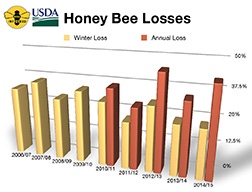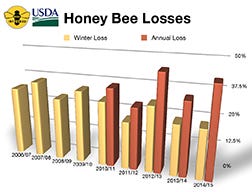Summer losses eclipse winter losses for the first time on record, according to study led by the University of Maryland.
May 13, 2015

Losses of managed honeybee colonies were 23.1% for the 2014-15 winter but summer losses exceeded winter numbers for the first time, making annual losses for the year 42.1%, according to preliminary results of the annual survey conducted by the Bee Informed Partnership (http://beeinformed.org), the U.S. Department of Agriculture and the Apiary Inspectors of America.
The winter loss improvement was about 0.6 percentage points less than the losses reported for the 2013-14 winter. This is the second year in a row that winter losses have been noticeably lower than the nine year average winter loss of 28.7%.

However, beekeepers are not losing colonies only in the winter but also throughout the summer, sometimes at significant levels. Summer losses for 2014 were reported as 27.4%, exceeding 2014-15 winter losses for the first time. In previous years, 2013 summer losses were reported as 19.8% compared to 23.7% for 2013-14 winter losses, and 2012 summer losses were reported as 25.3% compared to 30.5% for 2012-13 winter losses. Winter losses were considered October 2014 through April 2015.
Total annual losses were 42.1% for April 2014 through April 2015. The new figure is up from 34.2% for 2013-14.
"The winter loss numbers are more hopeful especially combined with the fact that we have not seen much sign of colony collapse disorder (CCD) for several years, but such high colony losses in the summer and year-round remain very troubling," said Jeff Pettis, a survey co-author and a senior entomologist at USDA's Agricultural Research Service Bee Research Laboratory in Beltsville, Md. “If beekeepers are going to meet the growing demand for pollination services, researchers need to find better answers to the host of stresses that lead to both winter and summer colony losses.”
About two-thirds of the beekeepers responding to the survey reported losses greater than the 18.7% level that beekeepers reported is economically acceptable. This underlines the seriousness of the health problems stressing honeybees in this country, Pettis pointed out.
“We traditionally thought of winter losses as a more important indicator of health, because surviving the cold winter months is a crucial test for any bee colony,” said Dennis vanEngelsdorp, an assistant professor of entomology at the University of Maryland and project director for the Bee Informed Partnership. However, "we now know that summer loss rates are significant too. This is especially so for commercial beekeepers, who are now losing more colonies in the summertime compared to the winter. Years ago, this was unheard of.
"Backyard beekeepers were more prone to heavy mite infestations, but we believe that is because a majority of them are not taking appropriate steps to control mites,” vanEngelsdorp said. “Commercial keepers were particularly prone to summer losses, but they typically take more aggressive action against Varroa mites, so there must be other factors at play."
For these preliminary survey results, more than 6,100 beekeepers across the country who managed almost 400,000 colonies in October 2014, representing nearly 15.5% of the country's 2.74 million colonies, responded to the survey.
A loss of 23.7% of managed honeybee colonies was reported for the 2013-14 winter and 30.5% loss for the winter of 2012-13. Previous surveys found winter losses of 21.9% in 2011-12, 30% in 2010-11, 33.8% in 2009-10, about 29% in 2008-09, about 36% in 2007-08 and about 32% in 2006-2007. Annual colonies losses were 34.2% for 2013-14, 45% for 2012-13, 28.9% for 2011-12 and 36.4% for 2010-11.
The survey is part of a larger research effort to understand why honey bee colonies are in such poor health, and what can be done to manage the situation. Colony losses present a financial burden for beekeepers, and can lead to shortages among the many crops that depend on honey bees as pollinators. Some crops, such as almonds, depend entirely on honey bees for pollination. Estimates of the total economic value of honey bee pollination services range between $10 billion and $15 billion annually.
A complete analysis of the survey data will be published later this year. The abstract for the analysis is at http://beeinformed.org/results-categories/winter-loss-2014-2015/.
You May Also Like



